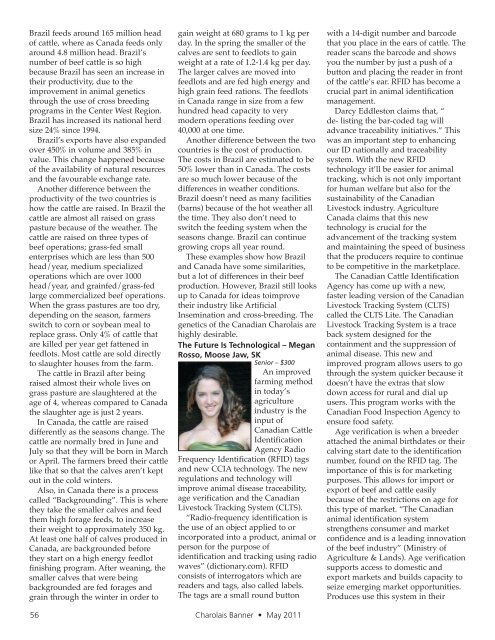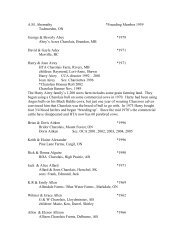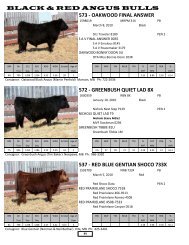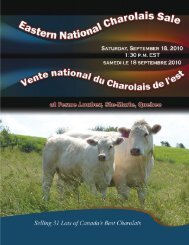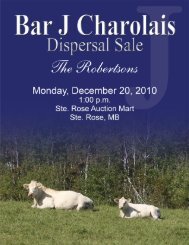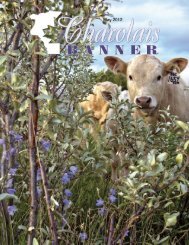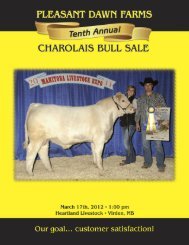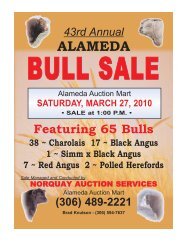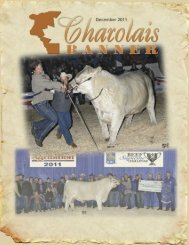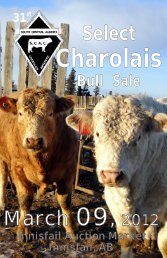May 2011 - Charolais Banner
May 2011 - Charolais Banner
May 2011 - Charolais Banner
- No tags were found...
You also want an ePaper? Increase the reach of your titles
YUMPU automatically turns print PDFs into web optimized ePapers that Google loves.
Brazil feeds around 165 million headof cattle, where as Canada feeds onlyaround 4.8 million head. Brazil’snumber of beef cattle is so highbecause Brazil has seen an increase intheir productivity, due to theimprovement in animal geneticsthrough the use of cross breedingprograms in the Center West Region.Brazil has increased its national herdsize 24% since 1994.Brazil’s exports have also expandedover 450% in volume and 385% invalue. This change happened becauseof the availability of natural resourcesand the favourable exchange rate.Another difference between theproductivity of the two countries ishow the cattle are raised. In Brazil thecattle are almost all raised on grasspasture because of the weather. Thecattle are raised on three types ofbeef operations; grass-fed smallenterprises which are less than 500head/year, medium specializedoperations which are over 1000head/year, and grainfed/grass-fedlarge commercialized beef operations.When the grass pastures are too dry,depending on the season, farmersswitch to corn or soybean meal toreplace grass. Only 4% of cattle thatare killed per year get fattened infeedlots. Most cattle are sold directlyto slaughter houses from the farm.The cattle in Brazil after beingraised almost their whole lives ongrass pasture are slaughtered at theage of 4, whereas compared to Canadathe slaughter age is just 2 years.In Canada, the cattle are raiseddifferently as the seasons change. Thecattle are normally bred in June andJuly so that they will be born in Marchor April. The farmers breed their cattlelike that so that the calves aren’t keptout in the cold winters.Also, in Canada there is a processcalled “Backgrounding”. This is wherethey take the smaller calves and feedthem high forage feeds, to increasetheir weight to approximately 350 kg.At least one half of calves produced inCanada, are backgrounded beforethey start on a high energy feedlotfinishing program. After weaning, thesmaller calves that were beingbackgrounded are fed forages andgrain through the winter in order togain weight at 680 grams to 1 kg perday. In the spring the smaller of thecalves are sent to feedlots to gainweight at a rate of 1.2-1.4 kg per day.The larger calves are moved intofeedlots and are fed high energy andhigh grain feed rations. The feedlotsin Canada range in size from a fewhundred head capacity to verymodern operations feeding over40,000 at one time.Another difference between the twocountries is the cost of production.The costs in Brazil are estimated to be50% lower than in Canada. The costsare so much lower because of thedifferences in weather conditions.Brazil doesn’t need as many facilities(barns) because of the hot weather allthe time. They also don’t need toswitch the feeding system when theseasons change. Brazil can continuegrowing crops all year round.These examples show how Braziland Canada have some similarities,but a lot of differences in their beefproduction. However, Brazil still looksup to Canada for ideas toimprovetheir industry like ArtificialInsemination and cross-breeding. Thegenetics of the Canadian <strong>Charolais</strong> arehighly desirable.The Future Is Technological – MeganRosso, Moose Jaw, SKSenior – $300An improvedfarming methodin today’sagricultureindustry is theinput ofCanadian CattleIdentificationAgency RadioFrequency Identification (RFID) tagsand new CCIA technology. The newregulations and technology willimprove animal disease traceability,age verification and the CanadianLivestock Tracking System (CLTS).“Radio-frequency identification isthe use of an object applied to orincorporated into a product, animal orperson for the purpose ofidentification and tracking using radiowaves” (dictionary.com). RFIDconsists of interrogators which arereaders and tags, also called labels.The tags are a small round buttonwith a 14-digit number and barcodethat you place in the ears of cattle. Thereader scans the barcode and showsyou the number by just a push of abutton and placing the reader in frontof the cattle’s ear. RFID has become acrucial part in animal identificationmanagement.Darcy Eddleston claims that, “de- listing the bar-coded tag willadvance traceability initiatives.” Thiswas an important step to enhancingour ID nationally and traceabilitysystem. With the new RFIDtechnology it’ll be easier for animaltracking, which is not only importantfor human welfare but also for thesustainability of the CanadianLivestock industry. AgricultureCanada claims that this newtechnology is crucial for theadvancement of the tracking systemand maintaining the speed of businessthat the producers require to continueto be competitive in the marketplace.The Canadian Cattle IdentificationAgency has come up with a new,faster leading version of the CanadianLivestock Tracking System (CLTS)called the CLTS Lite. The CanadianLivestock Tracking System is a traceback system designed for thecontainment and the suppression ofanimal disease. This new andimproved program allows users to gothrough the system quicker because itdoesn’t have the extras that slowdown access for rural and dial upusers. This program works with theCanadian Food Inspection Agency toensure food safety.Age verification is when a breederattached the animal birthdates or theircalving start date to the identificationnumber, found on the RFID tag. Theimportance of this is for marketingpurposes. This allows for import orexport of beef and cattle easilybecause of the restrictions on age forthis type of market. “The Canadiananimal identification systemstrengthens consumer and marketconfidence and is a leading innovationof the beef industry” (Ministry ofAgriculture & Lands). Age verificationsupports access to domestic andexport markets and builds capacity toseize emerging market opportunities.Produces use this system in their56 <strong>Charolais</strong> <strong>Banner</strong> • <strong>May</strong> <strong>2011</strong>


